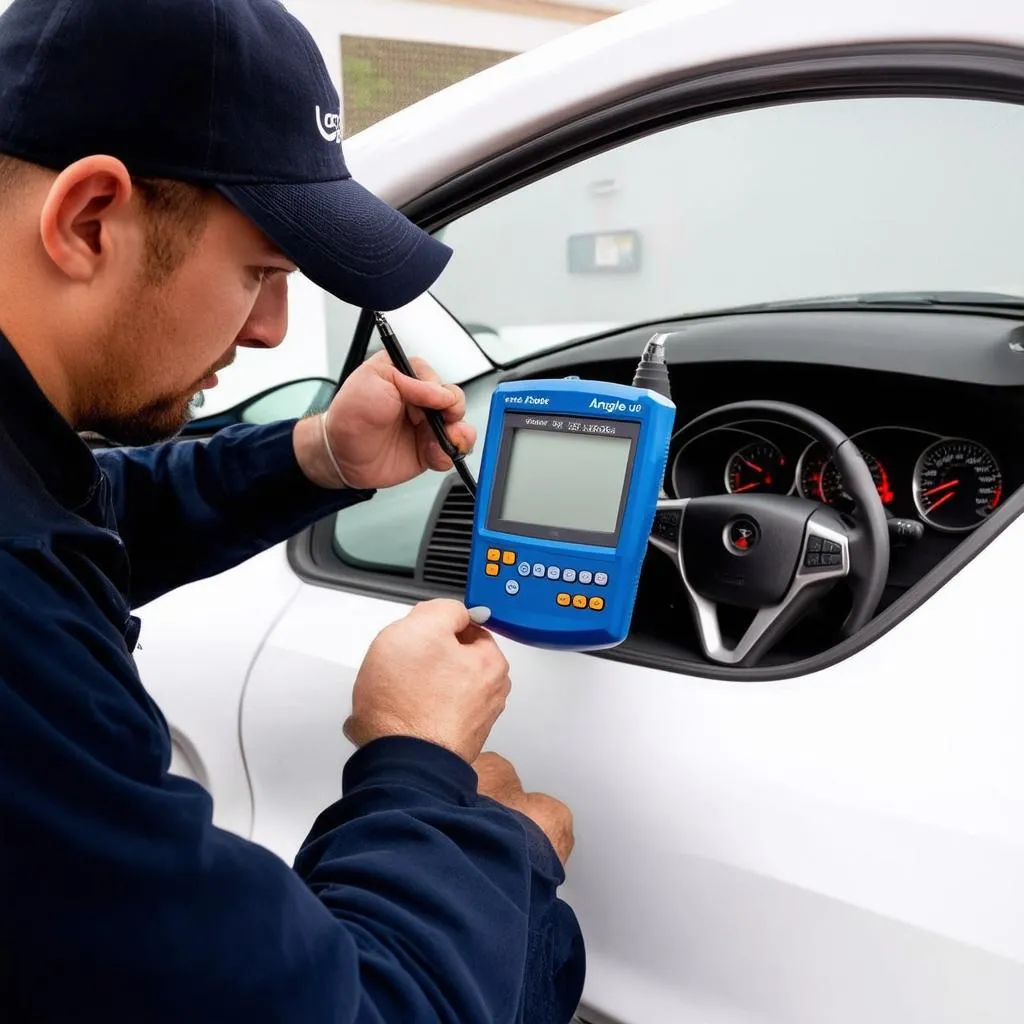Steering Angle Sensor Calibration VCDS: A Comprehensive Guide
Have you ever experienced your car’s steering wheel feeling “off” after an alignment, or perhaps after replacing a steering component? It’s possible that your steering angle sensor needs recalibration. This crucial sensor plays a vital role in providing your car’s Electronic Stability Control (ESC) system with accurate information about the steering wheel’s position.
Understanding Steering Angle Sensor Calibration and VCDS
What is a Steering Angle Sensor?
The steering angle sensor (SAS) is a vital component found in modern vehicles. It’s responsible for measuring the angle of the steering wheel, sending this data to the vehicle’s control unit (ECU). This information is essential for several safety and comfort features, including:
- Electronic Stability Control (ESC): This system uses the steering angle sensor data to determine the driver’s intended direction and intervene to help maintain stability in slippery conditions.
- Electric Power Steering (EPS): The steering angle sensor data helps calibrate the EPS system, providing assistance based on vehicle speed and steering input.
- Lane Departure Warning (LDW): The sensor helps the LDW system detect unintended lane changes, alerting the driver.
- Adaptive Cruise Control (ACC): The steering angle sensor data is used to adjust the vehicle’s speed and distance to other vehicles.
Why Do You Need Steering Angle Sensor Calibration?
Steering angle sensor calibration is essential after certain repairs or modifications that affect the steering system. This is usually performed with a specialized tool like VCDS (Vag-Com).
What is VCDS?
VCDS (VAG-COM) stands for “Vehicle Diagnostic System” or “Volkswagen Audi Group-COM.” It’s a popular diagnostic tool widely used by car enthusiasts and professional mechanics to access, diagnose, and program various vehicle control modules. It’s particularly known for its ability to perform advanced functions on Volkswagen, Audi, Seat, and Skoda vehicles.
When Does Steering Angle Sensor Calibration Become Necessary?
Steering angle sensor calibration is generally required in the following situations:
- Steering Wheel Replacement: Replacing the steering wheel often necessitates calibration of the steering angle sensor.
- Steering Column Replacement: If the steering column is replaced, recalibration is crucial to ensure accurate steering data.
- Steering Rack Replacement: When replacing the steering rack, a calibration procedure is usually required.
- Wheel Alignment: While not always necessary, a steering angle sensor calibration after a wheel alignment can help ensure the system’s accuracy.
How to Perform Steering Angle Sensor Calibration Using VCDS
Here’s a simplified overview of the steering angle sensor calibration process using VCDS:
- Connect VCDS: Connect the VCDS interface to your vehicle’s diagnostic port.
- Select Vehicle: Choose your car’s model and year from the VCDS software menu.
- Navigate to Steering Angle Sensor: Use the VCDS menus to locate the steering angle sensor calibration option.
- Follow Instructions: The VCDS software will provide clear instructions on how to perform the calibration procedure. This typically involves following a specific sequence of steering wheel movements.
- Complete Calibration: The software will guide you through the calibration steps and confirm when the process is complete.
Steering Angle Sensor Calibration: Frequently Asked Questions
Can I Calibrate the Steering Angle Sensor Myself?
While it’s possible to perform steering angle sensor calibration using VCDS, it’s crucial to have the proper knowledge and skills. Incorrect calibration can lead to safety issues and further damage. If you’re not comfortable performing this procedure yourself, seek professional assistance from a qualified mechanic or an expert in automotive diagnostics.
Is Steering Angle Sensor Calibration Necessary for All Cars?
Not all cars require steering angle sensor calibration. The need for calibration depends on the specific vehicle model and the type of repair or modification performed. It’s always best to consult your car’s owner’s manual or a trusted mechanic for guidance.
What Happens if I Don’t Calibrate the Steering Angle Sensor?
Failing to calibrate the steering angle sensor after a relevant repair can lead to various issues, including:
- Incorrect Steering Wheel Position: The steering wheel might not return to its center position after a turn.
- ESP Malfunction: The ESP system might not function correctly, leading to instability and safety risks.
- Erratic EPS Behavior: The electric power steering might feel jerky or inconsistent.
- Incorrect Lane Departure Warning: The LDW system may provide false alarms or fail to function as intended.
Steering Angle Sensor Calibration: A Vital Step for Safety and Performance
Steering angle sensor calibration is a crucial process that ensures the accuracy of your car’s steering system. By correctly calibrating the SAS, you can improve your vehicle’s safety, handling, and overall driving experience. Remember, proper calibration is essential for optimal performance and safety, so if you’ve performed any steering system repairs, ensure the sensor is correctly calibrated.
Need Help With Steering Angle Sensor Calibration?
 VCDS Steering Angle Sensor Calibration
VCDS Steering Angle Sensor Calibration
At CarDiagXpert.com, we understand the complexities of steering angle sensor calibration. Our team of experienced automotive professionals is dedicated to providing reliable support for all your vehicle diagnostic needs. If you need assistance with steering angle sensor calibration or have any questions, contact us via WhatsApp: +84767531508. We’re here to help you keep your car running smoothly and safely.
Additional Information and Resources
For further information about steering angle sensor calibration, explore these related articles:
- Steering Angle Adjust Using VCDS: Learn how to use VCDS to fine-tune your steering angle settings.
- VCDS for Skoda Cars: Discover the capabilities of VCDS for Skoda vehicles.
- VCDS: Start Lining Change Mode: Understand how VCDS can help with aligning your steering.
Please note: This information is for general guidance only. Always consult your car’s owner’s manual or a qualified mechanic for specific instructions related to your vehicle.
Share your experiences: Have you had any issues with your steering angle sensor? Share your thoughts and questions in the comments below!
